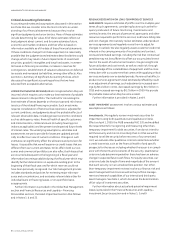GE 2011 Annual Report Download - page 65
Download and view the complete annual report
Please find page 65 of the 2011 GE annual report below. You can navigate through the pages in the report by either clicking on the pages listed below, or by using the keyword search tool below to find specific information within the annual report.
’
GE 2011 ANNUAL REPORT 63
Intercompany Eliminations
Effects of transactions between related companies are made on an arms-length basis, are eliminated and consist primarily of GECS
dividends to GE or capital contributions from GE to GECS; GE customer receivables sold to GECS; GECS services for trade receivables
management and material procurement; buildings and equipment (including automobiles) leased between GE and GECS; information
technology (IT) and other services sold to GECS by GE; aircraft engines manufactured by GE that are installed on aircraft purchased by
GECS from third-party producers for lease to others; and various investments, loans and allocations of GE corporate overhead costs.
For further information related to intercompany eliminations, see Note 27.
Contractual Obligations
As defi ned by reporting regulations, our contractual obligations for future payments as of December 31, 2011, follow.
Payments due by period
(In billions) Total 2012 2013–2014 2015–2016
2017 and
thereafter
Borrowings and bank deposits (Note 10) $453.4 $173.8 $104.5 $52.6 $122.5
Interest on borrowings and bank deposits 116.1 12.2 17.5 12.8 73.6
Purchase obligations (a) (b) 57.3 32.5 15.1 4.7 5.0
Insurance liabilities (Note 11) (c) 23.7 2.9 3.6 2.5 14.7
Operating lease obligations (Note 19) 4.5 1.0 1.4 0.9 1.2
Other liabilities (d) 73.6 23.5 12.5 8.0 29.6
Contractual obligations of discontinued operations (e) 1.4 1.4 — — —
(a) Included all take-or-pay arrangements, capital expenditures, contractual commitments to purchase equipment that will be leased to others, contractual commitments
related to factoring agreements, software acquisition/license commitments, contractual minimum programming commitments and any contractually required cash
payments for acquisitions.
(b) Excluded funding commitments entered into in the ordinary course of business by our financial services businesses. Further information on these commitments and other
guarantees is provided in Note 25.
(c) Included contracts with reasonably determinable cash flows such as structured settlements, certain property and casualty contracts, and guaranteed investment
contracts.
(d) Included an estimate of future expected funding requirements related to our pension and postretirement benefit plans and included liabilities for unrecognized tax
benefits. Because their future cash outflows are uncertain, the following non-current liabilities are excluded from the table above: deferred taxes, derivatives, deferred
revenue and other sundry items. For further information on certain of these items, see Notes 14 and 22.
(e) Included payments for other liabilities.
Variable Interest Entities (VIEs)
We securitize fi nancial assets and arrange other forms of asset-
backed fi nancing in the ordinary course of business as an
alternative source of funding. The securitization transactions we
engage in are similar to those used by many fi nancial institutions.
The assets we securitize include: receivables secured by
equipment, commercial real estate, credit card receivables, fl oor-
plan inventory receivables, GE trade receivables and other assets
originated and underwritten by us in the ordinary course of
business. The securitizations are funded with asset-backed com-
mercial paper and term debt.
Substantially all of our securitization VIEs are consolidated
because we are considered to be the primary benefi ciary of the
entity. Our interests in other VIEs for which we are not the primary
benefi ciary are accounted for as investment securities, fi nanc-
ing receivables or equity method investments depending on the
nature of our involvement.
At December 31, 2011, consolidated variable interest entity
assets and liabilities were $46.7 billion and $35.2 billion, respectively,
a decrease of $4.1 billion and $3.1 billion from 2010, respectively.
Assets held by these entities are of equivalent credit quality to
our on-book assets. We monitor the underlying credit quality in
accordance with our role as servicer and apply rigorous controls to
the execution of securitization transactions. With the exception of
credit and liquidity support discussed below, investors in these enti-
ties have recourse only to the underlying assets.
At December 31, 2011, investments in unconsolidated VIEs,
including our noncontrolling interest in PTL, were $16.5 billion, an
increase of $3.9 billion from 2010, primarily related to an increase
of $2.1 billion in an investment in asset-backed securities issued
by a senior secured loan fund and $1.2 billion in PTL. In addition to
our existing investments, we have contractual obligations to fund
additional investments in the unconsolidated VIEs to fund new
asset origination. At December 31, 2011, these contractual obliga-
tions were $4.3 billion, a decrease of $0.7 billion from 2010.
We do not have implicit support arrangements with any VIE.
We did not provide non-contractual support for previously trans-
ferred fi nancing receivables to any VIE in either 2011 or 2010.
























